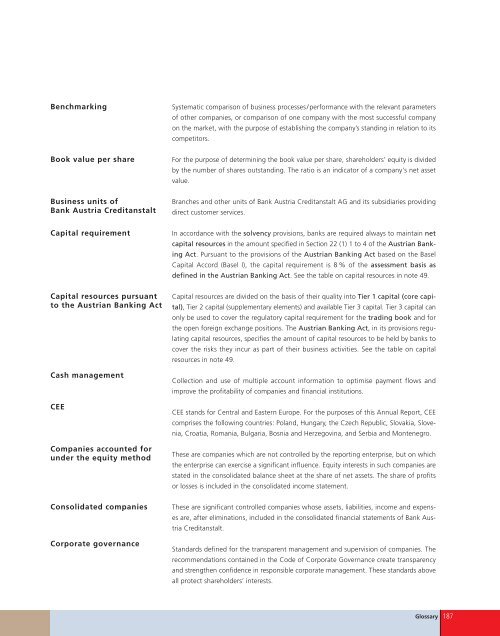team spirit - Bankier.pl
team spirit - Bankier.pl
team spirit - Bankier.pl
You also want an ePaper? Increase the reach of your titles
YUMPU automatically turns print PDFs into web optimized ePapers that Google loves.
Benchmarking<br />
Book value per share<br />
Business units of<br />
Bank Austria Creditanstalt<br />
Capital requirement<br />
Capital resources pursuant<br />
to the Austrian Banking Act<br />
Cash management<br />
CEE<br />
Companies accounted for<br />
under the equity method<br />
Consolidated companies<br />
Corporate governance<br />
Systematic comparison of business processes/performance with the relevant parameters<br />
of other companies, or comparison of one company with the most successful company<br />
on the market, with the purpose of establishing the company’s standing in relation to its<br />
competitors.<br />
For the purpose of determining the book value per share, shareholders’ equity is divided<br />
by the number of shares outstanding. The ratio is an indicator of a company's net asset<br />
value.<br />
Branches and other units of Bank Austria Creditanstalt AG and its subsidiaries providing<br />
direct customer services.<br />
In accordance with the solvency provisions, banks are required always to maintain net<br />
capital resources in the amount specified in Section 22 (1) 1 to 4 of the Austrian Banking<br />
Act. Pursuant to the provisions of the Austrian Banking Act based on the Basel<br />
Capital Accord (Basel I), the capital requirement is 8 % of the assessment basis as<br />
defined in the Austrian Banking Act. See the table on capital resources in note 49.<br />
Capital resources are divided on the basis of their quality into Tier 1 capital (core capital),<br />
Tier 2 capital (sup<strong>pl</strong>ementary elements) and available Tier 3 capital. Tier 3 capital can<br />
only be used to cover the regulatory capital requirement for the trading book and for<br />
the open foreign exchange positions. The Austrian Banking Act, in its provisions regulating<br />
capital resources, specifies the amount of capital resources to be held by banks to<br />
cover the risks they incur as part of their business activities. See the table on capital<br />
resources in note 49.<br />
Collection and use of multi<strong>pl</strong>e account information to optimise payment flows and<br />
improve the profitability of companies and financial institutions.<br />
CEE stands for Central and Eastern Europe. For the purposes of this Annual Report, CEE<br />
comprises the following countries: Poland, Hungary, the Czech Republic, Slovakia, Slovenia,<br />
Croatia, Romania, Bulgaria, Bosnia and Herzegovina, and Serbia and Montenegro.<br />
These are companies which are not controlled by the reporting enterprise, but on which<br />
the enterprise can exercise a significant influence. Equity interests in such companies are<br />
stated in the consolidated balance sheet at the share of net assets. The share of profits<br />
or losses is included in the consolidated income statement.<br />
These are significant controlled companies whose assets, liabilities, income and expenses<br />
are, after eliminations, included in the consolidated financial statements of Bank Austria<br />
Creditanstalt.<br />
Standards defined for the transparent management and supervision of companies. The<br />
recommendations contained in the Code of Corporate Governance create transparency<br />
and strengthen confidence in responsible corporate management. These standards above<br />
all protect shareholders’ interests.<br />
Glossary 187
















